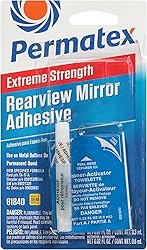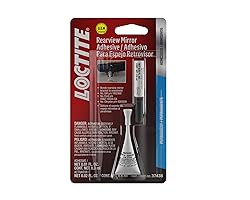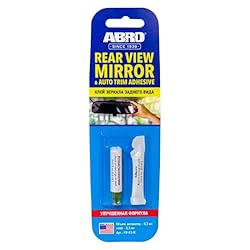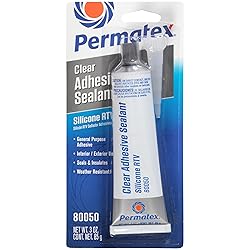There’s something especially annoying about driving with a missing rear view mirror. One day it’s hanging by a thread, the next it’s in your cupholder. And no – super glue won’t fix it.
Finding the best rear view mirror glue isn’t as simple as grabbing the first tube labeled “automotive adhesive.” Most glues either don’t bond well to glass and metal, or they break down under heat. I’ve tested more than a few, and trust me, some of them barely held through the weekend.
In this guide, I’ll walk you through the mirror adhesives that actually hold up – the ones that bond fast, survive summer heat, and don’t leave you re-gluing every month. Whether you’re fixing a fallen mirror or prepping for a full windshield swap, I’ve got you.
Best Rear View Mirror Glue in 2025
| Image | Model | |
|---|---|---|
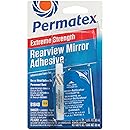 | Best OEM-Grade Glue for Permanent Mirror Fix Permatex 81840Editor's Choice | Check Price |
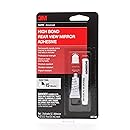 | Best Rearview Mirror Glue for High Heat and Vibration 3M High-BondCheck Price | Check Price |
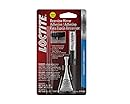 | Fastest-Setting Glue for Metal Mirror Mounts Loctite 37438Check Price | Check Price |
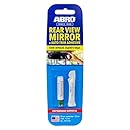 | Best Mirror Glue for Simple DIY Repairs ABRO Rear View Mirror AdhesiveCheck Price | Check Price |
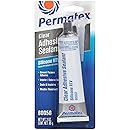 | Example of Using RTV Silicone for Rear View Mirrors Permatex 80050 RTVCheck Price | Check Price |
1. Permatex 81840 Extreme Rearview Mirror Adhesive Kit
If you’re looking for something that feels like it came straight from a dealership repair bay, this kit from Permatex gets close. It’s a two-part system with a medical-grade activator pad and a tiny vial of strong adhesive—just enough for a one-time fix, but it does the job right when used carefully.
The bond itself holds well under heat and vibration (which is where most cheap glues fail). I’ve used it through summer heat and bumpy roads without issue. You do have to follow the steps exactly, and I recommend letting it cure overnight for the best results.
Pros:
- OEM-spec adhesive that holds for years
- Includes activator towelette for clean, accurate prep
- Designed for glass-to-metal bonding
Cons:
- Single-use only — not much adhesive in the vial
2. 3M High-Bond Rearview Mirror Adhesive
I used this 3M kit when I needed a fast solution that could stand up to summer heat and a hot windshield. The two-step system is straightforward: activator first, then adhesive, and the bond starts grabbing within minutes. For a compact kit, it delivers a surprisingly solid hold.
Still, it’s not entirely foolproof. You really have to prep both surfaces properly, align the button exactly, and I recommend applying more pressure than the “60 seconds” the label suggests. I let mine cure a bit longer before attaching the mirror—and it’s held strong since.
Pros:
- Fast-curing adhesive — sets in about 15 minutes
- Good heat and vibration resistance
- Simple two-step application
Cons:
- Very small tube — enough for only one attempt
3. Loctite 37438 Rearview Mirror Adhesive Kit
This stuff sets fast. I’m talking seconds—not minutes—before the metal button grabs onto the glass like it’s never coming off. The full mounting strength kicks in around 15 minutes, so if you prep right and get the angle correct, you’re back on the road quick.
It’s especially solid for mirrors with heavier metal feet. I wouldn’t call it forgiving, though—if you misalign the button, good luck pulling it off again without a fight. But if you want the fastest rearview mirror adhesive that still holds like a champ, this is it.
Pros:
- Lightning-fast setting time
- Designed for metal-to-glass bonding
- OEM-approved by major car makers
Cons:
- No room for mistakes — minimal repositioning time
4. ABRO Rear View Mirror Adhesive Kit
This ABRO kit is made for quick mirror fixes without much hassle. It’s a two-step setup — you crush the activator vial, apply it, then follow up with the adhesive. The glue is fairly thick, sets fast, and works well if you need a simple solution that doesn’t require special tools or nerves of steel.
The instructions could definitely be clearer. I had to figure out the applicator logic on my own, but once that part was sorted, the process went smoothly. The bond felt strong after just a few minutes, and it held up even with a heavier mirror. For quick, no-frills repairs, it gets the job done — just don’t expect a ton of extra glue for future use.
Pros:
- Fast-setting adhesive with minimal setup
- Works for mirrors, trim, and moldings
- Affordable DIY-friendly kit
Cons:
- Unclear instructions — prep requires guesswork
5. Permatex 80050 Clear RTV Silicone Adhesive Sealant
Let’s get this straight — you don’t *have* to buy a special rear view mirror glue. Any 100% clear silicone sealant you have lying around can work. The one below is just an example of the kind you might use if you’re starting from scratch.
I’ve tested this method myself, and it can absolutely hold a rearview mirror in place. But here’s the deal — you need to prep like a pro. That means scraping both the mounting tab and the windshield clean, degreasing them with alcohol or acetone, and applying a thin, even layer of the silicone.
The biggest catch? Dry time. RTV silicone needs a full 24 hours to cure properly. That’s not ideal if you’re in a rush, but if you’re willing to wait, you can get a surprisingly solid and long-lasting bond. There’s even a great example on YouTube of someone using this method (not mine, just worth checking if you’re curious).
Pros:
- Available anywhere — even household silicone works
- Waterproof, flexible, and durable
- Great for multi-surface bonding beyond just mirrors
Cons:
- Long cure time — 24 hours minimum
What to Know Before Buying Rear View Mirror Glue
Most glues at the auto parts store will claim they can do it all – bond metal, plastic, and glass like magic. But rear view mirrors are a special case. You’re sticking a fairly heavy object (with leverage) onto a vertical surface, under glass, in a hot car. Not every glue is up for that.
Here’s what you should actually look for:
1. Dedicated Mirror Adhesive (Not Just “Super Glue”)
You need a glue that’s made specifically for rear view mirrors – usually a two-part system with an activator and adhesive. These are designed to handle the temperature swings and stress that generic glues can’t.
2. Fast Bonding Time
No one wants to hold a mirror against the windshield for 10 minutes. The best rearview mirror adhesive sets within seconds and cures fully in under 30 minutes. Some can hold in place almost instantly – that’s what you want.
3. High Heat Resistance
The inside of a car can hit 150°F or more on a sunny day. If the glue softens or fails at high temps, your mirror’s coming down again. Check that the product is rated for automotive use and explicitly mentions heat resistance.
4. Easy Application
Some kits are overengineered, with a dozen steps and tools you’ll never use. A good rear view mirror glue should be straightforward: clean, apply activator, press, done.
5. Don’t Reuse Old Adhesive
One quick tip: always scrape off any old glue before applying a new one. Even the best product won’t bond properly if you’re gluing over a failed surface. Razor blade + alcohol = clean slate.
Rear View Mirror Glue FAQ
Can I just use super glue for my rear view mirror?
Nope. Super glue might hold for a day or two, but it can’t handle the heat or stress. You need an adhesive specifically made for bonding metal to glass under pressure.
How long does rear view mirror glue take to cure?
Most proper mirror glues cure in under 30 minutes. Some set almost instantly, but always check the instructions – full strength may take a few hours.
Do I need to clean the glass before applying the glue?
Absolutely. Any dust, old glue, or oils will ruin the bond. Use a razor blade to scrape off the old stuff and clean with alcohol before applying the new adhesive.
Will the glue work in cold weather?
Most high-quality adhesives are rated for a wide temperature range, but curing time can slow down in cold temps. If it’s freezing out, do the job in a warm garage if you can.

